
S. R. Cranmer (1), L. Strachan (1), M. Romoli (2), D. Dobrzycka (1), A. V. Panasyuk (1), and J. L. Kohl (1)
(1) Smithsonian Astrophysical Observatory, Cambridge, MA 02138, USA
(2) Universita di Firenze, I-50125 Firenze, Italy
We compare UVCS/SOHO observations of densities and outflow velocities in polar coronal holes with theoretical mass-conservation models of an idealized force-free magnetostatic geometry. Open flux tubes bordering the closed-field streamer belt initially expand much more rapidly than flux tubes over the poles, then turn nearly radial and expand less rapidly. In the past, this variation in the superradial expansion factor has been inversely correlated with solar wind velocity at 1 AU, but we find an even stronger inverse correlation in the acceleration region of the solar wind (1 to 10 solar radii).
A considerable reduction in the wind speed of low-latitude flux tubes, compared with those over the poles, results in a geometry-dependent variation in the Doppler dimming of UV resonance lines such as H I Lyman alpha. Thus, we are able to use these emission diagnostics not only to infer the magnitude of the solar wind velocity, but also to map out the geometry of the solar wind emerging from large polar coronal holes.
This work is supported by NASA under Grant NAG5-3192 to the Smithsonian Astrophysical Observatory, by the Italian Space Agency, and by Swiss funding agencies.
 (Click on Figure for full-size GIF)
(Click on Figure for full-size GIF)
We use the same color code for flux tubes in most figures in this poster: BLUE tubes emerge from the poles, and RED tubes emerge from the edges of the coronal holes. The closed-field regions (ORANGE) do not enter into the following analysis of the solar wind.
The cross-sectional area of individual flux tubes is determined by the assumed magnetostatic model. We define the nonradial expansion factor f in terms of the area A:

If f equals 1, the expansion is in the form of "radial cones." If f is greater than 1, the expansion is "superradial." (See Wang and Sheeley 1990, for models with similar expansion morphology.)
Here we plot f(r) for the flux tubes plotted above, as well as the expansion factor for the entire coronal hole taken as a single flux "bundle." The expansion is very superradial, with asymptotic values of f of 5 to 7:
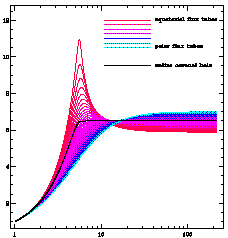 (Click on Figure for full-size GIF)
(Click on Figure for full-size GIF)
Notice especially the differences between the flux tubes along the poles and those bordering the edge of the streamer belt. These differences are averaged out when only looking at the expansion factor of the total bundle of coronal-hole flux tubes (black line).
Along each open flux tube, if we assume a time-steady flow, the equation of mass conservation gives:

The number density n is measured by UVCS in white light. Its latitudinal dependence is consant in coronal holes, with a sharp rise in equatorial streamers. The observed geometry for coronal holes has been inferred from a set of "synoptic" measurements made in November 1996, and empirically modeled as follows:
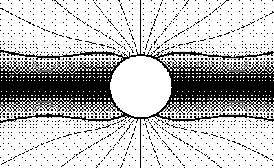 (Click on Figure for full-size GIF)
(Click on Figure for full-size GIF)
The flux-tube area A is given by the assumed magnetostatic model geometry, and the constant in the mass flux conservation equation is given by measurements at 1 AU (see, e.g., Goldstein et al. 1996, or the Ulysses/NASA Home Page).
Thus, we can solve for the wind velocity u along each flux tube:
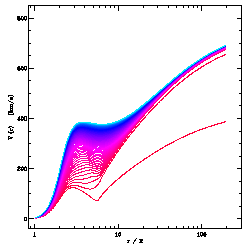 (Click on Figure for full-size GIF)
(Click on Figure for full-size GIF)
Note that most flux tubes have the same "terminal" velocity at 1 AU (with the exception of those nearest the high-density streamer belt). However, the pole-to-equator variations are much more gradual at lower radii in the corona. These variations are what we hope to measure with UVCS using the diagnostic of Lyman alpha Doppler dimming.
To test the derived wind velocity field, we scan coronal holes along constant radii in Lyman alpha radiation, and plot the relative intensity increase (from pole to equator) versus colatitude theta.
In the following figures, we compare observations (points) with three models:
Here we plot the comparisons at several heliocentric observing distances (1.5, 2.0, 2.5, 3.0, 3.5 solar radii):
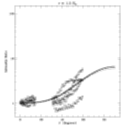
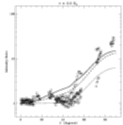
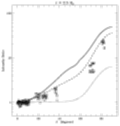
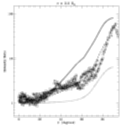
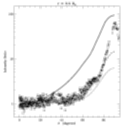 (Click on Figures for full-size GIFs)
(Click on Figures for full-size GIFs)
The model which seems to agree with most of the data points is the one with velocity vectors following the superradial flux tubes, but with no latitudinal variation in the velocity magnitude (dashed lines).
These results lead us to postulate a general qualitative requirement for future models of the fast solar wind emerging from polar coronal holes: a valid model of the large-scale magnetic field must have f(r) be more "evenly distributed" from pole to equator, than the force-free model presented here.
(Links are to ADS abstracts and, where available, full online papers.)
Charbonneau, P., and Hundhausen, A. J. 1996, Solar Phys., 165, 237
Goldstein, B. E., et al. 1996, Astron. and Astrophys., 316, 296
Guhathakurta, M., and Holzer, T. E. 1994, ApJ, 426, 782
Kohl, J. L., et al. 1995, Solar Phys., 162, 313
Kohl, J. L., et al. 1997, Solar Phys., 175, 613
Kohl, J. L., et al. 1998, ApJ Letters, 501, L127
Low, B. C. 1986, ApJ, 310, 953
Strachan, L., Kohl, J. L., Weiser, H., Withbroe, G. L., and Munro, R. H. 1993, ApJ, 412, 410
Wang, Y.-M., and Sheeley, N. R., Jr. 1990, ApJ, 355, 726
Withbroe, G. L., Kohl, J. L., Weiser, H., and Munro, R. H. 1982, Space Sci. Rev., 33, 17